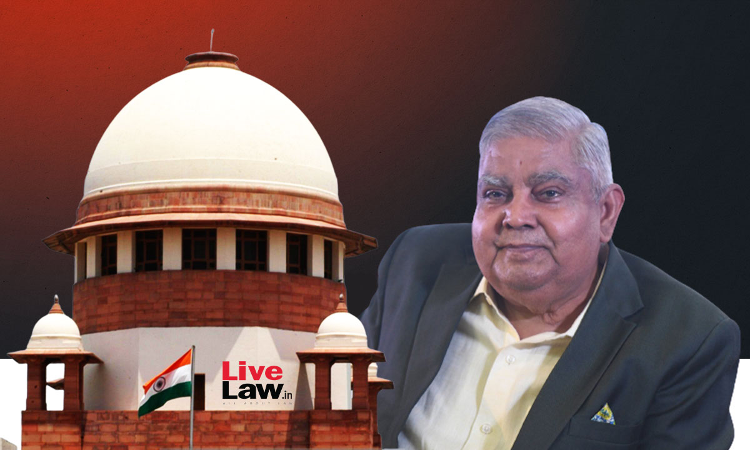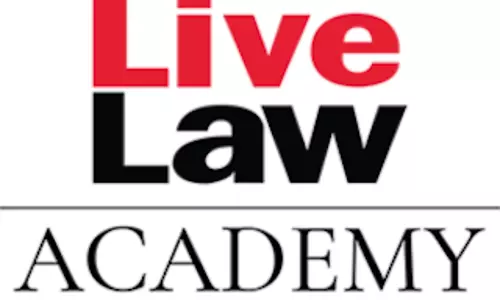Unwarranted Diatribe : On Vice President's Comments Against Supreme Court's Timelines For Bills' Assent
Manu Sebastian
19 April 2025 1:02 PM IST

The Supreme Court's judgment is not a 'nuclear missile' against democratic forces, but an antidote to constitutional paralysis.
Vice President Jagdeep Dhankhar's harsh outburst against the Supreme Court for setting a timeframe for the President to act on Bills referred by the Governor is quite uncharitable. The Vice President, with his comments ("There is a directive to the President by a recent judgment. Where are we heading? What is happening in the country?"), sounded alarm as if the Supreme Court had spelt doom for the country by merely stating that the President should decide on referred Bills within a specific timeframe. VP Dhankhar also went to the extent of saying that Article 142 has become a “nuclear missile” available with the judges against “democratic forces”.
These comments go beyond the realm of fair criticism and border on intimidation. The Vice President seemed to be projecting the President as a divine authority beyond reproach. The notion that the President is beyond accountability is plainly incorrect. “The immunity granted under Article 361 does not bar judicial review of the decision taken by the President under Article 356. It only bars personal appearance or prosecution of the President,” the Supreme Court had held in the Rameshwar Prasad case way back in 2006. In SR Bommai, the Supreme Court had held that Article 361 does not bar the Court from examining whether the President acted on the basis of sufficient materials.
President only a titular head
Under the Constitutional scheme, the President of India must act only as per the aid and advice of the Union Council of Ministers. It must be noted that the words used in Article 74 are “the President shall…”, implying its mandatory nature. This means that the President is only a titular head, with no independent decision-making power. In one sense, functionally, the President is more of a figurehead than the Governor. The Governor at least has some areas of individual discretion, such as the reporting of law and order breakdown under Art 356 or deciding which political party to invite to form the government after elections. The President has none and must act strictly as per the Union Government's advice. Therefore, a direction to the President is practically a direction to the Union Government. Given this framework, to frame the Supreme Court's direction as a blow to democratic norms is an overreaction.
Also, this is not the first time the Supreme Court has given a direction to the President. In the Shatrughan Chauhan case, the Supreme Court held that the President must decide mercy petitions of death row convicts “within a reasonable time”. It was held that “unreasonable, unexplained and exorbitant” delay in deciding mercy petitions can be a ground to commute death penalty, and fifteen death row inmates were released on this ground. Thus, there are precedents of the Supreme Court declaring the consequences of inaction on the part of the President. In the recent Balwant Singh case as well, the Supreme Court had set a deadline for a decision on the President's mercy petition and accountability was fixed on the concerned officer in the Ministry of Home Affairs for default.
Supreme Court only adopted the timelines suggested in Centre's guidelines
So, the Supreme Court's directions in State of Tamil Nadu vs Governor of Tamil Nadu cannot be said to be wholly unprecedented. It is an extension of the jurisprudence developed over the years in relation to judicial review of Presidential and Gubernatorial actions. Also, the Supreme Court's timelines were not pulled out of thin air. It was grounded in the recommendations made by the Sarkaria and Punchhi Commissions. Reference was also made to the Office Memorandum issued by the Ministry of Home Affairs, Government of India, dated 04.02.2016, which said that “A time limit of maximum 3 months be strictly adhered to for finalising the Bills after their receipt from the State Government”. Another government communication, also cited in the judgment, expressed concern over delays in clearing Bills. Thus, the Court in fact borrowed the timeline proposed by the Government itself. As observed by the Court :
We, therefore, deem it appropriate to adopt the timeline prescribed by the Ministry of Home Affairs in the aforesaid guidelines, and prescribe that the President is required to take a decision on the bills reserved for his consideration by the Governor within a period of three months from the date on which such reference is received.
On whether a 5-judge bench should have heard
The Vice President also appeared to question the legitimacy of the judgment on the ground that it was not delivered by a five-judge bench. As per Article 145(3) of the Constitution, a case involving a "substantial question of law as to the interpretation of the Constitution" must be heard by a bench of at least five judges. However, the principles laid down regarding the limited role of Governors are not novel, and the Court was following the long line of judgments from Shamsher Singh vs State of Punjab(7-judge bench), SR Bommai (5-judge bench), etc. The view that the Governor cannot exercise pocket veto and must return the Bill to the Assembly is an application of the recent judgment in the Punjab Governor case(3-judge bench). That a Bill re-enacted by the Assembly is binding on the Governor flows from a straight reading of the proviso to Article 200. Regarding the timelines, as stated above, the Court was adopting the guidelines prescribed by the Union Government itself. The power of the Court under Article 32, which in itself is a fundamental right, prevails over technical or procedural considerations. As for the Vice President's suggestion that Article 145(3) be amended to require a Constitution Bench comprising at least half the total strength of the Supreme Court (which would make it a bench of at least 17 judges), such a proposal is preposterously unviable.
Should Bills be indefinitely kept on hold?
One should also ask- after all, what is the prejudice caused by the Supreme Court's directions? Does the Vice President believe that Bills should be kept in limbo indefinitely? Even the Union Government had concerns about the delay in the process of clearing bills, as evident from its communications extracted in the judgment.
In that light, the Court's direction is not an affront to democracy; rather, it is a safeguard for it. Far from being a 'nuclear missile' against democratic forces, the Supreme Court's judgment is an antidote to constitutional paralysis.
Also, it's worth reflecting upon the circumstances that necessitated the Court's intervention - State Bills being kept pending for years without explanation. The Vice President should be equally concerned about this quiet legislative strangulation.
The Vice President, in his address, also mentioned the Justice Yashwant Varma episode and questioned the internal probe in the matter. That is indeed a matter requiring public debate. However, juxtaposing that issue with his comments against the judgment appeared to be laced with mala fides as a slander campaign to discredit the judiciary as a whole. Such attempts may not behove the high constitutional post, though largely ceremonial.
The Supreme Court's judgment aims to prevent a legislative deadlock and not to diminish the office of the President. Of course, the Supreme Court's Judgments are not beyond criticism, but they must be informed, temperate, and rooted in constitutional understanding. When high constitutional functionaries resort to alarmist language and distort established legal principles, it weakens the very fabric of democratic discourse they claim to defend.
The author is the Managing Editor of LiveLaw. He can be reached at manu@livelaw.in


